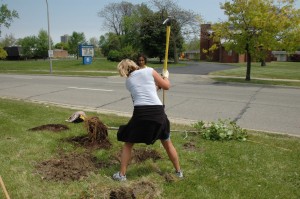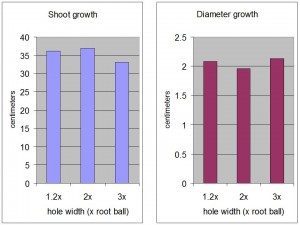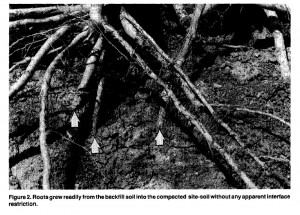One of my favorite bumper stickers from days gone by said simply “Stop Continental Drift”. Good luck with that.
Today’s topic deals with another type of drift – a phenomenon one of my professors referred at ‘Bibliographic drift’. This type of drift occurs when authors cite a paper without bothering to look up the original source. Then a second author cites original source based on the first author’s paper; then a third author cites it based on the second paper and so on and so forth. This is why grad students learn that second citing is a cardinal sin.
It’s an easy trap to fall into even in the age of access to electronic journals. It can happen in all sorts of ways, especially if the point the author trying to support is something that is intuitively appealing and not likely to be questioned. For example, I was recently reading through The Practical Science of Planting Trees by Gary Watson and E.B. Himelick. It’s a good book with lots of great info and photos but under the section on digging the planting hole there is a subsection “wider is better”. This is something we all ‘know’ but there is no data with any scientific rigor to support it; at least not that I’ve ever been able to find and I’ve looked repeatedly. So I was intrigued to see Watson and Himelick cite four papers to support the notion that wider is better. Cool. So I went through the bibliography to look up the citations.

First up, Arnold and Welsh 1995. Effects of planting hole configuration and soil type on transplant establishment of container-grown live oak. J. of Arboriculture 24:213-218. This paper doesn’t even discus planting hole width, at least not directly. The authors looked at various planting hole configurations (round, square, star-shaped) but made a point to keep the planting hole volume the same. Zero points for wider is better.
Next, Corley 1984. Soil amendments at planting J. Environ. Hort. 2:27-30. One of the experiments in this paper compared root and shoot growth of four shrub species transplanted from #1 containers into holes that were with 1.75x or 3.5x the width of the root-ball. The author measured root and shoot growth after two years and the results were a mixed bag. They found the wider hole was better about half the time, the other half of the time it didn’t make a difference. One point for wider is better (sort of).
Next, Montegue et al. 2007. Influence of irrigation volume and mulch on establishment of select shrub species Arboriculture & Urban Forestry. 33:202–209. The title of the paper says it all; the authors compared water relations and growth in response to mulch and irrigation but planting hole size wasn’t included as a variable. (Spoiler alert: mulch improved growth and water relations). Zero points.
Last and most interesting, Watson et al. 1992. The effect of backfill soil texture and planting hole shape on root regeneration of transplanted green ash. J. of Arboriculture 18:130-135. In this study the authors looked at new root growth and shoot and diameter growth for three years after transplanting green ash trees into planting holes that were 1.2x, 2x, or 3x the width of the root ball. And they found… nothing. Well, not nothing but they didn’t find any effects of planting hole size on root density, shoot growth or caliper growth. To help visualize the response I’ve summarized their growth data three years after transplanting below. One point for it doesn’t matter.

As a final note I include a photo from the Waston et al. paper 1992. The photo is fuzzy but the caption should be clear.
So where does that leave us? Digging a wider hole doesn’t hurt, except maybe your back. And I think that’s part of the appeal of this advice: If it’s more work it must be better. Dig a hole 2 times, 3 times, 10 times the width of the root-ball if you want. Just don’t say “Research shows wider is better…” because it’s ambiguous at best.


Great investigation! Thanks for making my life a “hole” lot easier in the garden. I am delighted to understand I have no need for all that extra work when I plant.
I may need to rethink my planting procedures of incantations, astrology chart, magic pixie dust and those eye-of-newt amendments as well!
The standard advice to dig a wider planting hole, such as what you find in this peer-reviewed extension publication here (http://anrcatalog.ucdavis.edu/pdf/8046.pdf) goes back to research by Dr. Richard W. Harris at UC Davis, Hickman, Svihra, and others. I think you’ll probably find research by Dr. Shigo as well on the topic. Dr. Harris was working on this topic in the 1960’s and 70’s, so it is possible you won’t find online references; you’ll simply find most articles link back to his widely-used textbooks on arboriculture. Those are part of the ISA standards and are widely considered to be evidence-based. I don’t think this article posted here trumps that history. It makes a good point about the use of citations, but I think you’ll need to dig a lot deeper before you can conclude that we need to think again about wider planting holes.
I can be convinced. Show me the data.
Bar charts without standard deviations or standard errors displayed are not useful either – zero points.
Look up the reference by Watson et al. There was no effect (P>0.05) of planting hole size for any response variable. I converted their table into a figure. If they had provided standard errors I would have presented them. Got a beef? Take it up with Gary Watson.
Great post, Bert!
(and appropriate *pfffttt*)
HS
https://extension.arizona.edu/sites/extension.arizona.edu/files/resources/transplantingacacia.pdf
Effect of Planting Hole Size and Amendments on Growth and Establishment of Acacia farnesiana
not peer reviewed